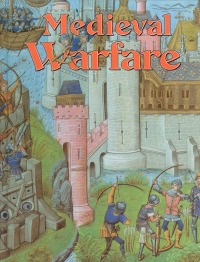| ________________
CM . . .
. Volume X Number 12. . . . February 13, 2004
excerpt:
The "Medieval World Series" will be a very welcome addition to middle school libraries. Kay Eastman has done a marvelous job depicting the lives of kings and queens, lords and ladies, the clergy, town and trades folk and peasants under the hierarchical feudal pyramid. As an added benefit, she also offers students glimpses into the similarities and differences of some of the great cultures, particularly the Islamic and Japanese, which existed outside Christian European during the Medieval period. The titles are all superbly illustrated with full color scenes which capture the essence of medieval life, renditions of major artistic works from the period, and photographs of important artifacts and major European sites. Each book begins with a time-line and ends with a 25 to 30-word glossary which is relevant to the book's major theme. The time-line of Medieval Society begins with the fall of the Roman Empire, notes the dates of the Viking invasions, the growth of towns, the arrival of the plague, the invention of the printing press, and Columbus's voyage to the new world. The Life of a Knight time-line tells us when stirrups and chain mail armor were invented, the codes of chivalry were developed, the introduction of the longbow and gunpowder, and finally the end of knights as mounted warriors. The life and times of Eleanor of Aquitaine, the Abbess Heloise, Joan of Arc and Isabella I of Spain are a selection of the women pointed out in Women and Girls in the Middle Ages. A few of the terms defined in Life in a Castle are "almoner," "moat," "plumber," "survey," and "tax"; Places of Worship defines "archbishop," "Holy Land," "mosaic," "sin," and "saint," whereas Medieval Warfare identifies the meaning of "aqueduct," "moat," "spur," "raid," and "invader." Medieval Society is the series' core title outlining the highly developed social structure of medieval feudalism. It defines the social roles and obligations of each layer of the hierarchy, explaining how power, wealth and status flowed down from the king to the lords, their vassals, and townsfolk, ultimately to the mass of impoverished peasant-serfs. Women and Girls in the Middle Ages examines the important roles women played in the day-to-day running of the Lord's castle, the serf's land, the church or the tradesperson's business. Sections of both books examine the daily lives of each class: the differences in the foods they ate, the games they played, the jobs they were allowed to have, and the overriding importance religion provided. Overall there is a wealth of general information to inspire budding medievalists. Although there are some redundancies, Life in a Castle, The Life of a Knight, and Medieval Warfare make-up a very nicely integrated set. A Medieval Lord had no status if he had no land and castle to protect it. Students will learn how castles became virtual towns and increasingly complex over the 1000-year period that made up the Middle Ages. Because warfare was an integral aspect of the medieval social system, the lord relied on his mounted knights to protect his territory. Eastman examines how knights were trained for war from early childhood, lived by knightly codes of chivalry, and how they constantly prepared for battle by participating in tournaments. Like castles, the knight's armor, weapons, and use of his horse evolved over the long period of Medieval history. The wealth and power of the Catholic Church and overarching important role it played in the daily lives of all Medieval people are the foci of Places of Worship in the Middle Ages. Students will gain knowledge of how the church was the center of all religious, private and community activity. As they read this book, students will learn about feasting and fasting, the crusades and religious pilgrimages to far away churches to pray at sacred relics. They will also learn how the great medieval cathedrals were built and decorated by the intricate use of stained glass and monumental stone carvings. Equally important to understanding the Middle Ages is the role monasteries and convents played in preserving knowledge, educating and caring for the community's poor and sick. Recommended. Ian Stewart teaches at David Livingstone School in Winnipeg, MB.
To comment
on this title or this review, send mail to cm@umanitoba.ca.
Copyright © the Manitoba Library Association. Reproduction for personal
use is permitted only if this copyright notice is maintained. Any
other reproduction is prohibited without permission.
NEXT REVIEW |TABLE OF CONTENTS FOR THIS ISSUE
- February 13, 2004.
AUTHORS
| TITLES | MEDIA REVIEWS
| PROFILES
| BACK ISSUES
| SEARCH | CMARCHIVE
| HOME |





